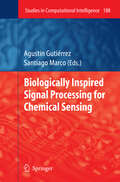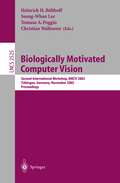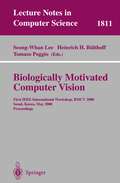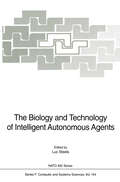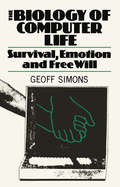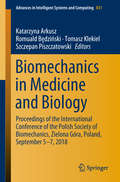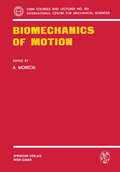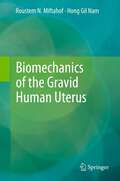- Table View
- List View
Biologically-Inspired Collaborative Computing: IFIP 20th World Computer Congress, Second IFIP TC 10 International Conference on Biologically-Inspired Collaborative Computing, September 8-9, 2008, Milano, Italy (IFIP Advances in Information and Communication Technology #268)
by Mike Hinchey Anastasia Pagnoni Franz J. Rammig Hartmut Schmeck“Look deep into nature and you will understand everything better.” advised Albert Einstein. In recent years, the research communities in Computer Science, Engineering, and other disciplines have taken this message to heart, and a relatively new field of “biologically-inspired computing” has been born. Inspiration is being drawn from nature, from the behaviors of colonies of ants, of swarms of bees and even the human body. This new paradigm in computing takes many simple autonomous objects or agents and lets them jointly perform a complex task, without having the need for centralized control. In this paradigm, these simple objects interact locally with their environment using simple rules. Applications include optimization algorithms, communications networks, scheduling and decision making, supply-chain management, and robotics, to name just a few. There are many disciplines involved in making such systems work: from artificial intelligence to energy aware systems. Often these disciplines have their own field of focus, have their own conferences, or only deal with specialized s- problems (e.g. swarm intelligence, biologically inspired computation, sensor networks). The Second IFIP Conference on Biologically-Inspired Collaborative Computing aims to bridge this separation of the scientific community and bring together researchers in the fields of Organic Computing, Autonomic Computing, Self-Organizing Systems, Pervasive Computing and related areas. We are very pleased to have two very important keynote presentations: Swarm Robotics: The Coordination of Robots via Swarm Intelligence Principles by Marco Dorigo (Université Libre de Bruxelles, Belgium), of which an abstract is included in this volume.
Biologically Inspired Control of Humanoid Robot Arms: Robust and Adaptive Approaches
by Adam Spiers Said Ghani Khan Guido HerrmannThis book investigates a biologically inspired method of robot arm control, developed with the objective of synthesising human-like motion dynamically, using nonlinear, robust and adaptive control techniques in practical robot systems. The control method caters to a rising interest in humanoid robots and the need for appropriate control schemes to match these systems. Unlike the classic kinematic schemes used in industrial manipulators, the dynamic approaches proposed here promote human-like motion with better exploitation of the robot’s physical structure. This also benefits human-robot interaction.The control schemes proposed in this book are inspired by a wealth of human-motion literature that indicates the drivers of motion to be dynamic, model-based and optimal. Such considerations lend themselves nicely to achievement via nonlinear control techniques without the necessity for extensive and complex biological models.The operational-space method of robot control forms the basis of many of the techniques investigated in this book. The method includes attractive features such as the decoupling of motion into task and posture components. Various developments are made in each of these elements. Simple cost functions inspired by biomechanical “effort” and “discomfort” generate realistic posture motion. Sliding-mode techniques overcome robustness shortcomings for practical implementation. Arm compliance is achieved via a method of model-free adaptive control that also deals with actuator saturation via anti-windup compensation. A neural-network-centered learning-by-observation scheme generates new task motions, based on motion-capture data recorded from human volunteers. In other parts of the book, motion capture is used to test theories of human movement. All developed controllers are applied to the reaching motion of a humanoid robot arm and are demonstrated to be practically realisable.This book is designed to be of interest to those wishing to achieve dynamics-based human-like robot-arm motion in academic research, advanced study or certain industrial environments. The book provides motivations, extensive reviews, research results and detailed explanations. It is not only suited to practising control engineers, but also applicable for general roboticists who wish to develop control systems expertise in this area.
Biologically Inspired Cooperative Computing: IFIP 19th World Computer Congress, TC 10: 1st IFIP International Conference on Biologically Inspired Cooperative Computing, August 21-24, 2006, Santiago, Chile (IFIP Advances in Information and Communication Technology #216)
by Yi Pan Mauricio Solar Franz J. Rammig Hartmut SchmeckIn the world of information technology, it is no longer the computer in the classical sense where the majority of IT applications is executed; computing is everywhere. More than 20 billion processors have already been fabricated and the majority of them can be assumed to still be operational. At the same time, virtually every PC worldwide is connected via the Internet. This combination of traditional and embedded computing creates an artifact of a complexity, heterogeneity, and volatility unmanageable by classical means. Each of our technical artifacts with a built-in processor can be seen as a ''Thing that Thinks", a term introduced by MIT's Thinglab. It can be expected that in the near future these billions of Things that Think will become an ''Internet of Things", a term originating from ETH Zurich. This means that we will be constantly surrounded by a virtual "organism" of Things that Think. This organism needs novel, adequate design, evolution, and management means which is also one of the core challenges addressed by the recent German priority research program on Organic Computing.
Biologically Inspired Design: Computational Methods and Tools
by Ashok K. Goel Daniel A. McAdams Robert B. StoneFrom simple cases such as hook and latch attachments found in Velcro to articulated-wing flying vehicles, biology often has been used to inspire many creative design ideas. The scientific challenge now is to transform the paradigm into a repeatable and scalable methodology. Biologically Inspired Design explores computational techniques and tools that can help integrate the method into design practice. With an inspiring foreword from Janine Benyus, Biologically Inspired Design contains a dozen chapters written by some of the leading scholars in the transdisciplinary field of bioinspired design, such as Frank Fish, Julian Vincent and Jeannette Yen from biology, and Amaresk Chakrabarti, Satyandra Gupta and Li Shu from engineering. Based in part on discussions at two workshops sponsored by the United States National Science Foundation, this volume introduces and develops several methods and tools for bioinspired design including: Information-processing theories, Natural language techniques,Knowledge-based tools, andFunctional approaches and Pedagogical techniques.By exploring these fundamental theories, techniques and tools for supporting biologically inspired design, this volume provides a comprehensive resource for design practitioners wishing to explore the paradigm, an invaluable guide to design educators interested in teaching the method, and a preliminary reading for design researchers wanting to investigate bioinspired design.
Biologically-Inspired Optimisation Methods: Parallel Algorithms, Systems and Applications (Studies in Computational Intelligence #210)
by Andrew Lewis Sanaz Mostaghim Marcus RandallBiologically Inspired Robot Behavior Engineering (Studies in Fuzziness and Soft Computing #109)
by Richard J. Duro Jose Santos Manuel GranaThe book presents an overview of current research on biologically inspired autonomous robotics from the perspective of some of the most relevant researchers in this area. The book crosses several boundaries in the field of robotics and the closely related field of artificial life. The key aim throughout the book is to obtain autonomy at different levels. From the basic motor behavior in some exotic robot architectures right through to the planning of complex behaviors or the evolution of robot control structures, the book explores different degrees and definitions of autonomous behavior. These behaviors are supported by a wide variety of modeling techniques: structural grammars, neural networks, and fuzzy logic and evolution underlies many of the development processes. Thus this text can be used by scientists and students interested in these areas and provides a general view of the field for a more general audience.
Biologically Inspired Signal Processing for Chemical Sensing (Studies in Computational Intelligence #188)
by Agustín Gutiérrez Santiago MarcoBiologically inspired approaches for artificial sensing have been extensively applied to different sensory modalities over the last decades and chemical senses have been no exception. The olfactory system, and the gustatory system to a minor extent, has been regarded as a model for the development of new artificial chemical sensing s- tems. One of the main contributions to this field was done by Persaud and Dodd in 1982 when they proposed a system based on an array of broad-selective chemical sensors coupled with a pattern recognition engine. The array aimed at mimicking the sensing strategy followed by the olfactory system where a population of bro- selective olfactory receptor neurons encodes for chemical information as patterns of activity across the neuron population. The pattern recognition engine proposed was not based on bio-inspired but on statistical methods. This influential work gave rise to a new line of research where this paradigm has been used to build chemical sensing instruments applied to a wide range of odor detection problems. More recently, some researchers have proposed to extend the biological inspiration of this system also to the processing of the sensor array signals. This has been mo- vated in part by the increasing body of knowledge available on biological olfaction, which has become in the last decade a focus of attention of the experimental neu- science community.
Biologically Inspired Techniques in Many Criteria Decision Making: Proceedings of BITMDM 2021 (Smart Innovation, Systems and Technologies #271)
by Sung-Bae Cho Satchidananda Dehuri Bhabani Shankar Prasad Mishra Pradeep Kumar MallickThis book includes best-selected, high-quality research papers presented at Second International Conference on Biologically Inspired Techniques in Many Criteria Decision Making (BITMDM 2021) organized by Department of Information & Communication Technology, Fakir Mohan University, Balasore, Odisha, India, during December 20-21, 2021. This proceeding presents the recent advances in techniques which are biologically inspired and their usage in the field of many criteria decision making. The topics covered are biologically inspired algorithms, nature-inspired algorithms, multi-criteria optimization, multi-criteria decision making, data mining, big-data analysis, cloud computing, IOT, machine learning and soft computing, smart technologies, crypt-analysis, cognitive informatics, computational intelligence, artificial intelligence and machine learning, data management exploration and mining, computational intelligence, and signal and image processing.
Biologically Inspired Techniques in Many-Criteria Decision Making: International Conference on Biologically Inspired Techniques in Many-Criteria Decision Making (BITMDM-2019) (Learning and Analytics in Intelligent Systems #10)
by Satchidananda Dehuri Bhabani Shankar Prasad Mishra Pradeep Kumar Mallick Sung-Bae Cho Margarita N. FavorskayaThis book addresses many-criteria decision-making (MCDM), a process used to find a solution in an environment with several criteria. In many real-world problems, there are several different objectives that need to be taken into account. Solving these problems is a challenging task and requires careful consideration. In real applications, often simple and easy to understand methods are used; as a result, the solutions accepted by decision makers are not always optimal solutions. On the other hand, algorithms that would provide better outcomes are very time consuming. The greatest challenge facing researchers is how to create effective algorithms that will yield optimal solutions with low time complexity. Accordingly, many current research efforts are focused on the implementation of biologically inspired algorithms (BIAs), which are well suited to solving uni-objective problems. This book introduces readers to state-of-the-art developments in biologically inspired techniques and their applications, with a major emphasis on the MCDM process. To do so, it presents a wide range of contributions on e.g. BIAs, MCDM, nature-inspired algorithms, multi-criteria optimization, machine learning and soft computing.
Biologically Motivated Computer Vision: Second International Workshop, BMCV 2002, Tübingen, Germany, November 22-24, 2002, Proceedings (Lecture Notes in Computer Science #2525)
by Heinrich H. Bülthoff Seong-Whan Lee Tomaso Poggio Christian WallravenThis book constitutes the refereed proceedings of the Second International Workshop on Biologically Motivated Computer Vision, BMCV 2002, held in Tübingen, Germany, in November 2002.The 22 revised full papers and 37 revised short papers presented together with 6 invited papers were carefully reviewed and selected from 97 submissions. The papers are organized in topical sections on neurons and features, motion, mid-level vision, recognition - from scenes to neurons, attention, robotics, and cognitive vision.
Biologically Motivated Computer Vision: First IEEE International Workshop BMCV 2000, Seoul, Korea, May 15-17, 2000 Proceedings (Lecture Notes in Computer Science #1811)
by Seong-Whang Lee Heinrich H. Bülthoff Tomaso PoggioIt is our great pleasure and honor to organize the First IEEE Computer Society International Workshop on Biologically Motivated Computer Vision (BMCV 2000). The workshop BMCV 2000 aims to facilitate debates on biologically motivated vision systems and to provide an opportunity for researchers in the area of vision to see and share the latest developments in state-of-the-art technology. The rapid progress being made in the field of computer vision has had a tremendous impact on the modeling and implementation of biologically motivated computer vision. A multitude of new advances and findings in the domain of computer vision will be presented at this workshop. By December 1999 a total of 90 full papers had been submitted from 28 countries. To ensure the high quality of workshop and proceedings, the program committee selected and accepted 56 of them after a thorough review process. Of these papers 25 will be presented in 5 oral sessions and 31 in a poster session. The papers span a variety of topics in computer vision from computational theories to their implementation. In addition to these excellent presentations, there will be eight invited lectures by distinguished scientists on “hot” topics. We must add that the program committee and the reviewers did an excellent job within a tight schedule.
Biologically Rationalized Computing Techniques For Image Processing Applications (Lecture Notes in Computational Vision and Biomechanics #25)
by Jude Hemanth Valentina Emilia BalasThis book introduces readers to innovative bio-inspired computing techniques for image processing applications. It demonstrates how a significant drawback of image processing – not providing the simultaneous benefits of high accuracy and less complexity – can be overcome, proposing bio-inspired methodologies to help do so. Besides computing techniques, the book also sheds light on the various application areas related to image processing, and weighs the pros and cons of specific methodologies. Even though several such methodologies are available, most of them do not provide the simultaneous benefits of high accuracy and less complexity, which explains their low usage in connection with practical imaging applications, such as the medical scenario. Lastly, the book illustrates the methodologies in detail, making it suitable for newcomers to the field and advanced researchers alike.
Biologische Rhythmen und Arbeit: Bausteine zur Chronobiologie und Chronohygiene der Arbeitsgestaltung
by Gunther HildebrandtThe Biology and Technology of Intelligent Autonomous Agents (NATO ASI Subseries F: #144)
by Luc SteelsThe NATO sponsored Advanced Study Institute 'The Biology and Tech nology of Intelligent Autonomous Agents' was an extraordinary event. For two weeks it brought together the leading proponents of the new behavior oriented approach to Artificial Intelligence in Castel Ivano near Trento. The goal of the meeting was to establish a solid scientific and technological foun dation for the field of intelligent autonomous agents with a bias towards the new methodologies and techniques that have recently been developed in Ar tificial Intelligence under the strong influence of biology. Major themes of the conference were: bottom-up AI research, artificial life, neural networks and techniques of emergent functionality. The meeting was such an extraordinary event because it not only featured very high quality lectures on autonomous agents and the various fields feeding it, but also robot laboratories which were set up by the MIT AI laboratory (with a lab led by Rodney Brooks) and the VUB AI laboratory (with labs led by Tim Smithers and Luc Steels). This way the participants could also gain practical experience and discuss in concreto what the difficulties and achievements were of different approaches. In fact, the meeting has been such a success that a follow up meeting is planned for September 1995 in Monte Verita (Switzerland). This meeting is organised by Rolf Pfeifer (University of Zurich).
The Biology of Computer Life: Survival, Emotion and Free Will
by SIMONSThe doctrine of computer life is not congenial to many people. Often they have not thought in any depth about the idea, and it necessarily disturbs their psychological and intellectual frame of reference: it forces a reappraisal of what it is to be alive, what it is to be human, and whether there are profound, yet un expected, implications in the development of modern com puters. There is abundant evidence to suggest that we are wit nessing the emergence of a vast new family of life-forms on earth, organisms that are not based on the familiar metabolic chemistries yet whose manifest 'life credentials' are accumulating year by year. It is a mistake to regard biology as a closed science, with arbitrarily limited categories; and we should agree with Jacob (1974) who observed that 'Contrary to what is imagined, biology is not a unified science'. Biology is essentially concerned with living things, and we should be reluctant to assume that at anyone time our concept and understanding of life are complete and incapable of further refinement. And it seems clear that much of the continuing refinement of biological categories will be stimulated by advances in systems theory, and in particular by those advances that relate to the rapidly expanding world of computing and robotics. We should also remember what Pant in (1968) said in a different context: 'the biological sciences are unrestricted . . . and their investigator must be prepared to follow their problems into any other science whatsoever.
Biomechanical Biofeedback Systems and Applications (Human–Computer Interaction Series)
by Anton Kos Anton UmekThis book deals with the topic of biomechanical biofeedback systems and applications that are primarily aimed at motor learning in sports and rehabilitation. It gives a comprehensive tutorial of the concepts, architectures, operation, and exemplary applications of biomechanical biofeedback systems. A special section is dedicated to various constraints in designing biomechanical biofeedback systems. The book also describes the technologies needed for the adequate operation of biofeedback systems, such as motion tracking, communication, processing, and sensor technologies. In regard to technologies, the emphasis is on the assurance of the requirements of the real-time system operation. The application focus is on the usage in sport and rehabilitation, particularly in the field of accelerated motor learning and injury prevention. We include several examples of operational (real-time) biofeedback applications in golf, skiing, and swimming. The book is in the first place intended for the professional audience, researchers, and scientists in the fields connected to the topics of this book.
Biomechanical Models for Soft Tissue Simulation (ESPRIT Basic Research Series)
by Walter Maurel Yin Wu Nadia Magnenat Thalmann Daniel ThalmannAn overview of biomechanical modeling of human soft tissue using nonlinear theoretical mechanics and incremental finite element methods, useful for computer simulation of the human musculoskeletal system.
Biomechanics and Sports: Proceedings of the XI Winter Universiads 2003 (CISM International Centre for Mechanical Sciences #473)
by Paolo B. PascoloOn XXI Winter Universiads 2003, CISM offered its scientific contribution by hosting a conference on mechanics applied to sports and, in general, to human movement. The conference was conceived as a chance to overview experiences gained from several operators working on different aspects of biomechanics. The reader will face in these proceedings bioengineering aspects, control issues, techniques for the optimization of human performances as well as methods for the improvement of athletic equipments and devices. Biomechanical data and signal processing, biomaterials and robotics complete the proposed framework. Some works were consistent with the fact that 2003 was designated as European Year of Disabled People. Indeed, many innovations in sport and biomechanics could suggest interesting rehabilitative applications and a better prevention of some pathologies due to the exercise of some normal activities like professional cycling. Ž
Biomechanics in Medicine and Biology: Proceedings of the International Conference of the Polish Society of Biomechanics, Zielona Góra, Poland, September 5-7, 2018 (Advances in Intelligent Systems and Computing #831)
by Szczepan Piszczatowski Tomasz Klekiel Romuald Będziński Katarzyna ArkuszThis book presents the proceedings of the “International Conference of the Polish Society of Biomechanics – BIOMECHANICS 2018” held in Zielona Góra, Poland from September 5 to 7, 2018, and discusses recent research on innovations in biomechanics.It includes a collection of selected papers in all key areas of biomechanics, including cellular, molecular, neuro and musculoskeletal biomechanics, as well as sport, clinical and rehabilitation biomechanics. These themes are extremely important in the development of engineering concepts and methods to provide new medical solutions, especially in the context of an ageing population.Presenting the latest technical advances and research methods used in clinical biomechanics, this book is of interest to scientists as well as junior researchers and students of interdisciplinary fields of engineering, medical, and sports sciences.
Biomechanics of Anthropomorphic Systems (Springer Tracts in Advanced Robotics #124)
by Gentiane Venture Jean-Paul Laumond Bruno WatierMechanical laws of motion were applied very early for better understanding anthropomorphic action as suggested in advance by Newton «For from hence are easily deduced the forces of machines, which are compounded of wheels, pullies, levers, cords, and weights, ascending directly or obliquely, and other mechanical powers; as also the force of the tendons to move the bones of animals». In the 19th century E.J. Marey and E. Muybridge introduced chronophotography to scientifically investigate animal and human movements. They opened the field of motion analysis by being the first scientists to correlate ground reaction forces with kinetics.Despite of the apparent simplicity of a given skilled movement, the organization of the underlying neuro-musculo-skeletal system remains unknown. A reason is the redundancy of the motor system: a given action can be realized by different muscle and joint activity patterns, and the same underlying activity may give rise to several movements. After the pioneering work of N. Bernstein in the 60’s on the existence of motor synergies, numerous researchers «walking on the border» of their disciplines tend to discover laws and principles underlying the human motions and how the brain reduces the redundancy of the system. These synergies represent the fundamental building blocks composing complex movements.In robotics, researchers face the same redundancy and complexity challenges as the researchers in life sciences. This book gathers works of roboticists and researchers in biomechanics in order to promote an interdisciplinary research on anthropomorphic systems at large and on humanoid robotics in particular.
Biomechanics of Cells and Tissues: Experiments, Models and Simulations (Lecture Notes in Computational Vision and Biomechanics)
by Paola LeccaThe application of methodological approaches and mathematical formalisms proper to Physics and Engineering to investigate and describe biological processes and design biological structures has led to the development of many disciplines in the context of computational biology and biotechnology. The best known applicative domain is tissue engineering and its branches. Recent domains of interest are in the field of biophysics, e.g.: multiscale mechanics of biological membranes and films and filaments; multiscale mechanics of adhesion; biomolecular motors and force generation. Modern hypotheses, models, and tools are currently emerging and resulting from the convergence of the methods and phylosophycal apporaches of the different research areas and disciplines. All these emerging approaches share the purpose of disentangling the complexity of organisms, tissues, and cells and mimiking the function of living systems.The contributions presented in this book are current research highlights of six challenging and representative applicative domains of phyisical, engineering, and computational approaches in medicine and biology, i.e tissue engineering, modelling of molecular structures, cell mechanics and cell adhesión processes, cancer physics, and physico-chemical processes of metabolic interactions. Each chapter presents a compendium or a review of the original results achieved by authors in the last years. Furthermore, the book also wants to pinpoint the questions that are still open and that could propel the future research.
Biomechanics of the Gravid Human Uterus
by Roustem N. Miftahof Hong Gil NamThe complexity of human uterine function and regulation is one of the great wonders of nature and represents a daunting challenge to unravel. This book is dedicated to the biomechanical modeling of the gravid human uterus and gives an example of the application of the mechanics of solids and the theory of soft shells to explore medical problems of labor and delivery. After a brief overview of the anatomy, physiology and biomechanics of the uterus, the authors focus mainly on electromechanical wave processes, their origin, dynamics, and neuroendocrine and pharmacological modulations. In the last chapter applications, pitfalls and problems related to modeling and computer simulations of the pregnant uterus and pelvic floor structures are discussed. A collection of exercises is added at the end of each chapter to help readers with self-evaluation.The book serves as an invaluable source of information for researchers, instructors and advanced undergraduate and graduate students interested in systems biology, applied mathematics and biomedical engineering.
Biomechanics of the Human Urinary Bladder
by Roustem N. Miftahof Hong Gil NamAs a research subject, the biomechanics of the urinary bladder are relatively young, yet medical problems associated with them are as old as mankind. Offering an update on recent achievements in the field, the authors highlight the underlying biological, chemical and physical processes of bladder function and present the systematic development of a mathematical model of the organ as a thin, soft biological shell. The book will be a valuable resource for postgraduate students and researchers interested in the applications of computational mathematics and solid mechanics to modern problems in biomedical engineering and medicine.
The Biomechanics of the Tactile Perception of Friction (Springer Series on Touch and Haptic Systems)
by Laurence WillemetHumans rely on their sense of touch to perceive subtle movements and micro slippages to manipulate an impressive range of objects. This incredible dexterity relies on fast and unconscious adjustments of the grip force that holds an object strong enough to avoid a catastrophic fall yet gentle enough not to damage it. The Biomechanics of the Tactile Perception of Friction covers how the complex mechanical interaction is perceived by the nervous system to quickly infer the state of the contact for a swift and precise regulation of the grip. The first part focuses on how humans assess friction at the contact initialization and the second part highlights an efficient coding strategy that the nervous system might use to continuously adjust the grip force to keep a constant safety margin before slippage. Taken together, these results reveal how the perception of frictional information is encoded in the deformation of our skin. The findings are useful for designing bio-inspired tactile sensors for robotics or prosthetics and for improving haptic human-machine interactions.






